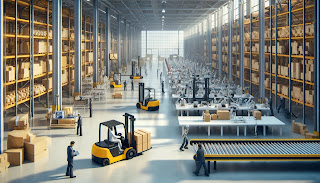In the rapidly evolving landscape of supply chain management, automation is often hailed as the panacea for efficiency woes. However, as we delve deeper, it’s crucial to consider whether this rush towards automation is genuinely beneficial or if it’s another trend fueled by industry hype.
The Automation Surge
Post-pandemic, many supply chains have turned to automation to cope with unprecedented demand and labor shortages. Companies like Amazon and Home Depot have invested heavily in automated systems, expecting long-term gains in efficiency and cost reduction. Yet, the question remains: are these investments sustainable?
Strategy vs. Tactics
A fundamental issue lies in distinguishing between strategic, long-term plans and short-term tactical responses. The pandemic-induced surge was an anomaly, not a new norm. Investing in automation based on such a temporary spike may not align with sustainable growth principles. Strategic planning must extend beyond immediate gains and consider long-term market stability.
The Market-Driven Approach
Successful supply chain management begins with understanding market needs. Often, leaders become enamored with the technology itself, forgetting that the primary goal is to meet market demands efficiently. This approach necessitates a keen focus on market trends and customer requirements, tailoring the supply chain to serve these needs first.
Scenario Planning
Predicting the future is inherently fraught with uncertainty. Rather than committing to a single vision, scenario planning allows for flexibility, preparing for multiple potential outcomes. This strategy involves monitoring key indicators and maintaining operational flexibility until clearer trends emerge.
Change Management
At the heart of any transformation is change management. Effective communication and stakeholder engagement are vital in navigating the complexities of automation. Ensuring that all levels of the organization understand and buy into the transformation strategy is essential for successful implementation.
The Risk of Rigidity
Automation can lead to increased rigidity within supply chains, reducing their ability to adapt to unforeseen changes. As Elon Musk famously acknowledged, excessive automation can be a misstep. Balancing human oversight with technological advances is crucial to maintaining agility and responsiveness.
Conclusion
While automation offers significant potential benefits, it is not a one-size-fits-all solution. Strategic thinking, market alignment, scenario planning, and robust change management practices are essential to navigating the future of supply chain management. By considering these elements, companies can avoid the pitfalls of excessive automation and create resilient, adaptable supply chains.
**Join the discussion! What are your thoughts on the future of supply chain automation? Comment below.
- SEO Powered Content & PR Distribution. Get Amplified Today.
- PlatoData.Network Vertical Generative Ai. Empower Yourself. Access Here.
- PlatoAiStream. Web3 Intelligence. Knowledge Amplified. Access Here.
- PlatoESG. Carbon, CleanTech, Energy, Environment, Solar, Waste Management. Access Here.
- PlatoHealth. Biotech and Clinical Trials Intelligence. Access Here.
- Source: https://10xlogistics.blogspot.com/2024/06/supply-chain-automation-is-it-truly.html




